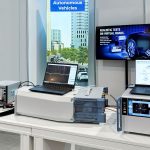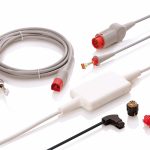Capturing data from machines and analysing it to discover trends can give greater knowledge of production processes, better insights into maintenance status, improved product quality and reduced energy use, is allowing manufacturing companies to take advantage of digitalisation. At heart of this digitalisation is the Industrial Internet of Things (IIoT), where sensors placed on conveyors, production machinery and in warehouses are linked to remote cloud-based computing facilities via gateways, to enable manufacturers to gain real insight and knowledge into how their assets are performing and how to improve them. Position sensing technologies such as imaging and RFID are key here, which track the flow of product carriers. There are also environmental sensors that send vital data about aspects such as humidity and temperature that can affect raw materials and the processes that convert them into finished goods. This means there is a need for sensors with a wide range of sensing modes, alongside ease of installation, ensuring the right kind of sensor is used in the right place, giving reliable communication in insight.
Condition monitoring of machines, tools and other equipment is another vital aspect in industrial applications. Devices such as the WISE-2410 LoRaWAN wireless condition monitor sensor from Advantech can monitor the status of machinery by measuring vibration and surface temperatures. The sensor can diagnose anomalies using criteria specified in the ISO 10816 vibration monitoring standard, avoiding the need for users to create their own analysis tools. Protected to IP66, the sensor can be used in a wide range of applications including HVAC systems, pumps, motors and facilities monitoring.
Wireless brings huge flexibility
Installing sensors where they are needed is made much easier by wireless technologies such as Bluetooth, LoRaWAN and Sigfox. Sensors that need fixed network connectivity can cause problems, especially if changes to the production layout require devices such as presence detection sensors to be moved or realigned. Using wireless connectivity, sensors simply need a power source, with many of them relying on batteries. They are often so efficient that standard batteries can last several years or even decades before needing replacement.
A major advantage of wireless-enabled sensors is that many incorporate their own microcontrollers. This allows them to process and format data before transmitting it, ensuring they filter out unimportant data to minimise the traffic being sent to the network.
Standard wireless protocols also ensure that sensors are compatible with a wide variety of off-the-shelf gateways, which properly format this data into IP frames for relaying to the cloud or edge computers. Some technologies, such LoRaWAN and Sigfox, deliver data over even longer distances before needing to be relayed by a gateway. LoRaWAN also offers enhanced security, featuring built-in encryption to protect both network and user data.
All these standard protocols allow easy upgrades, another big benefit in industrial settings.
Keeping emissions in check
IIoT solutions can also help companies contribute to reducing the effect of carbon emissions, which reached a global peak of 36.7 billion tonnes in 2019. The figure is 60% higher than in 1990, placing great pressure on manufacturers to bring emissions under control.
Part of this can be achieved by introducing the control systems into the feedback loops that can use the large amounts of computational power available from cloud and edge computing. Then, cloud servers can run AI models that learn how best to plan for changes in energy use in different parts of the production cycles or at different times of day, to, for example, respond to weather and other environmental changes ensuring systems such as HVACs or other process equipment involving heating or cooling are working optimally and using the appropriate amount of power.
Maximising the efficient use of both energy and materials comes from knowing when and how to operate the machinery. Industry 4.0 technologies use both short- and long-range communications to allow local control systems to share information. Examples of uses designed to save energy include ensuring conveyors are only active when products need to be moved around the plant. Machine tools can be powered down if components are not currently being processed or made ready to accept a new component to its production cell. Such a system will make extensive use of sensors and computing platforms which receive data from across the plant and make decisions in real time based on the data they receive.
Here, too, wireless protocols such as Bluetooth, Wi-Fi and LoRaWAN make it easier to deploy sensors where they are needed most, allowing a focus on the most energy-intensive processes. Because of their nature and flexibility, incorporating such sensors as well as cloud assistance avoids having to overhaul existing control systems, with the programmable logic controllers (PLCs) that manage individual machine tools often being suitable for many years.
Partnerships
The initial implementation stage of industrial automation applications usually involves large budgets with off-the-shelf products sourced from a small number of manufacturers. However, maintaining or upgrading an existing production line is very different, with the work usually needing to be carried out quickly, to avoid losses caused by equipment downtime.
Any distributor chosen to help manage maintenance and upgrades to a production line should offer several key characteristics – service level, product range, availability and warranty, and scaleability. Under service level, the logistic ability of the distributor is crucial. Engineers must receive the required products quickly, particularly important when parts are being replaced to minimise the downtime of a production line. There are only a few specialised global distributors, such as Farnell, who can offer both a broad range of products and short lead times.
The ordering process itself should also be painless. Farnell offers a suite of value-added services designed to aid the ordering and delivery of parts for existing production lines. Engineers can easily identify suitable parts and order them quickly using Farnell’s comprehensive resources, which include datasheets, application notes, certifications and images and videos.
Product range, availability and warranty are also vital. To get spare parts to engineers rapidly, the distributor must have first-class relationships with global suppliers of all the technologies required. Farnell offers solutions from over 75 suppliers, carrying a vast range of products, available in large quantities immediately. Products are also backed by industry-standard manufacturer warranties.
When upgrading an existing production line to support growth, it’s likely that some form of customisation will be required. Farnell customers can also take advantage of specialist design services, manufacturing support or life cycle services, without having to engage with additional partners, minimising design-to-production time.
By Mathew Thorpe, Regional Sales Director of UK, Ireland and Benelux, Farnell










